One of the stories is about a character whose car breaks down loudly in a quiet neighbourhood. He parks the best he can by a corner and calls the car recovery service. While he waits, he notices somebody waiting next to a wall in the distance, seemingly doing nothing and starts to worry about this guy. The other story is about a woman trying to sleep in the house next to where the breakdown from the first story happens. Her house was recently burgled and she is alone and worried about the loud noises she hears outside. She decides to check out what is going on, but can only see the arm of somebody inside a poorly parked car just under her window, not sure what to make of him. I decided that I wanted to create an image that would encompass the two main characters from each story, bringing them together but at a distance, representing their fears and apprehensions. This would be better achieved by using a wide-angle lens, which has the effect of enlarging the scene.The main set would be the street just outside our home, and we used our car as a prop for a broken down vehicle that came stationary by the corner of the house. I tried two different points of view for this: one from the top floor of our house, looking down, and another one from the inside of the vehicle looking up towards the top floor of the house.I did some testing of the scene looking down, from inside the upper floor room of the house. These shots were taken with a 14mm equivalent lens. I was primarily concerned about the lightning conditions, as I wanted the subject looking through the window, to be illuminated but did not want the room to be fully lit. I wanted to recreate the lighting conditions of a reading light. At first I tried a bedside table lamp, but this was too unfocused and did not really illuminate the subject (see picture one below). My second attempt was using a spotlight from the other side of the room, opposite the window. In here, the light was more directional but also harsher, creating strong highlight blocks in the curtains and the frames of the windows (see figure 2 below).
My second attempt was using a spotlight from the other side of the room, opposite the window. In here, the light was more directional but also harsher, creating strong highlight blocks in the curtains and the frames of the windows (see figure 2 below). A final attempt was made by using a light box just on the side next to the subject. This to me created the best effect in terms of achieving the desired side illumination of the subject without brightening the inside of the room excessively (see figure 3 below).
A final attempt was made by using a light box just on the side next to the subject. This to me created the best effect in terms of achieving the desired side illumination of the subject without brightening the inside of the room excessively (see figure 3 below). I also did some tests inside the car. The first attempts were made with a mobile phone, equipped with a 31mm equivalent lens. This gave a slightly more compressed view than what I was looking for, and did not allow much by way of context, but I felt that it provided an interesting basis to work with.
I also did some tests inside the car. The first attempts were made with a mobile phone, equipped with a 31mm equivalent lens. This gave a slightly more compressed view than what I was looking for, and did not allow much by way of context, but I felt that it provided an interesting basis to work with. Following these proof of concept shots, I decided to concentrate on the picture from inside the car. The reason for this is that it allows me to show the face of the driver and to play with his expression in order to convey his anguish, as described at the end of the story. In the picture from the top room, the character would have to be shown in profile and this did not allow for any expressiveness, diminishing the impact of the image. I also was more pleased with how the elements balanced out in the car shot. The second test was performed with a 14-28mm equivalent zoom lens. I tried to place the camera in a similar place where I had my mobile, just behind the helm.
Following these proof of concept shots, I decided to concentrate on the picture from inside the car. The reason for this is that it allows me to show the face of the driver and to play with his expression in order to convey his anguish, as described at the end of the story. In the picture from the top room, the character would have to be shown in profile and this did not allow for any expressiveness, diminishing the impact of the image. I also was more pleased with how the elements balanced out in the car shot. The second test was performed with a 14-28mm equivalent zoom lens. I tried to place the camera in a similar place where I had my mobile, just behind the helm. Following the second test, I decided to tackle the illumination problems in the two sets separately. The upper room set was illuminated using a large soft box on the right hand side, which would provide the main source of illumination, and a small LED box on the left hand side to provide fill light on the other side, complemented by a bed-side lamp with a warm lightbulb. Initially I also kept the main room light on, but this resulted in too much illumination for the upper room, compared with the light available inside the car, which made balancing the final exposure more difficult. In the end, I decided to turn this off and just leave the bedside table light on, together with the soft-box and LED box. The main lighting set-up for the upper room is shown below.
Following the second test, I decided to tackle the illumination problems in the two sets separately. The upper room set was illuminated using a large soft box on the right hand side, which would provide the main source of illumination, and a small LED box on the left hand side to provide fill light on the other side, complemented by a bed-side lamp with a warm lightbulb. Initially I also kept the main room light on, but this resulted in too much illumination for the upper room, compared with the light available inside the car, which made balancing the final exposure more difficult. In the end, I decided to turn this off and just leave the bedside table light on, together with the soft-box and LED box. The main lighting set-up for the upper room is shown below.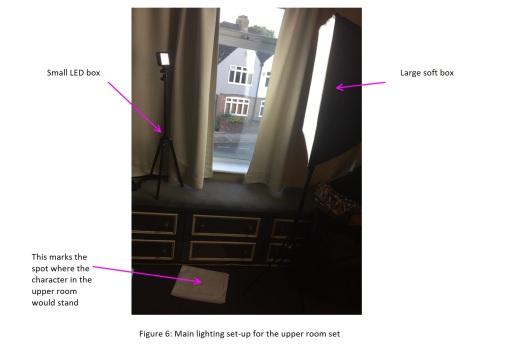 Inside the car, I had two main problems. The roof was too dark and the overall illumination of the subject was too poor. In the story, the character is playing with his phone while he waits for the recovery service. I decided it would be a good idea then to complement the ambient light by illumination from a phone, placed in front of the subject close to where the camera was set. The car has a cup holder next to the door and it would fit a mobile phone. It is conceivable that the driver would place his phone here while he takes a break from the Internet and watches the stranger that has captured his attention and has him worried for some time now (as per the storyline). This not only lifted the subject but also added some light to the roof of the car, which was primarily large black surface in the test pictures. In order to stabilize the camera in position, I crafted a narrow support plank with 5mm foam board, to which a flash bracket was fixed in order to be able to mount the camera and allow for some side adjustments for framing. The plank was resting on the main steering column on one side and on a tripod on the other. A pre-final test was taken to check for any final lighting problems and also to determine the final position of the characters:
Inside the car, I had two main problems. The roof was too dark and the overall illumination of the subject was too poor. In the story, the character is playing with his phone while he waits for the recovery service. I decided it would be a good idea then to complement the ambient light by illumination from a phone, placed in front of the subject close to where the camera was set. The car has a cup holder next to the door and it would fit a mobile phone. It is conceivable that the driver would place his phone here while he takes a break from the Internet and watches the stranger that has captured his attention and has him worried for some time now (as per the storyline). This not only lifted the subject but also added some light to the roof of the car, which was primarily large black surface in the test pictures. In order to stabilize the camera in position, I crafted a narrow support plank with 5mm foam board, to which a flash bracket was fixed in order to be able to mount the camera and allow for some side adjustments for framing. The plank was resting on the main steering column on one side and on a tripod on the other. A pre-final test was taken to check for any final lighting problems and also to determine the final position of the characters: For the final shot, I decided to try two alternatives to the mobile phone I used to illuminate the subject inside the car, as I still thought that the car and room illumination was too unbalanced. The first one was a small LED flash (two LEDs), but this source of illumination proved to be too strong and harsh on the subject. The second option was to use a tablet to illuminate the subject rather than a phone. In the end, the latter was the preferred option given that it provided a large, soft source of light and enabled a better balance between the two sets (as previously advised, I also reduced the light inside the second set in the upper room). Because this light essentially cancelled the slant shadow created by the external lamp-post, I experimented by adding a second led light on a stand just outside the car to complement the street light, but in the end decided not to use it for the final shot.
For the final shot, I decided to try two alternatives to the mobile phone I used to illuminate the subject inside the car, as I still thought that the car and room illumination was too unbalanced. The first one was a small LED flash (two LEDs), but this source of illumination proved to be too strong and harsh on the subject. The second option was to use a tablet to illuminate the subject rather than a phone. In the end, the latter was the preferred option given that it provided a large, soft source of light and enabled a better balance between the two sets (as previously advised, I also reduced the light inside the second set in the upper room). Because this light essentially cancelled the slant shadow created by the external lamp-post, I experimented by adding a second led light on a stand just outside the car to complement the street light, but in the end decided not to use it for the final shot.

 The final shot was taken with the characters dressed as intended. The man (myself) on the car was wearing a long, clear smart shirt, as if he was returning home from a long day at the office. I opted for clear tones here to aid with the illumination, as previous tests with darker casual clothing resulted in almost no highlights inside the car. The subject wore no glasses to avoid any distracting specular highlights. The character in the upper room (my partner) was told to look down towards the subject inside the car, who in turn is looking away, with a stern, concerned look. It is like if the characters were serially connected rather than making direct contact with each other, their anguish traveling from the upper room set, to the car, and then out of the frame.Technically, the final photograph, which is shown below, was taken as two separate exposures, one focused on the interior of the car and a second one focused on the window of the upper room. Both exposures where then combined in Photoshop. Distracting specular highlights and reflections on the house windows were cloned out or toned down in post processing. Other than this, most of the post processing adjustments where for colour balance, white / black points and shadow levels, with mild noise reduction applied. The picture was cropped to a 6×7 format to reduce negative space on the right hand side and to increase tension by having the main character looking out so close to the edge of the frame.
The final shot was taken with the characters dressed as intended. The man (myself) on the car was wearing a long, clear smart shirt, as if he was returning home from a long day at the office. I opted for clear tones here to aid with the illumination, as previous tests with darker casual clothing resulted in almost no highlights inside the car. The subject wore no glasses to avoid any distracting specular highlights. The character in the upper room (my partner) was told to look down towards the subject inside the car, who in turn is looking away, with a stern, concerned look. It is like if the characters were serially connected rather than making direct contact with each other, their anguish traveling from the upper room set, to the car, and then out of the frame.Technically, the final photograph, which is shown below, was taken as two separate exposures, one focused on the interior of the car and a second one focused on the window of the upper room. Both exposures where then combined in Photoshop. Distracting specular highlights and reflections on the house windows were cloned out or toned down in post processing. Other than this, most of the post processing adjustments where for colour balance, white / black points and shadow levels, with mild noise reduction applied. The picture was cropped to a 6×7 format to reduce negative space on the right hand side and to increase tension by having the main character looking out so close to the edge of the frame.



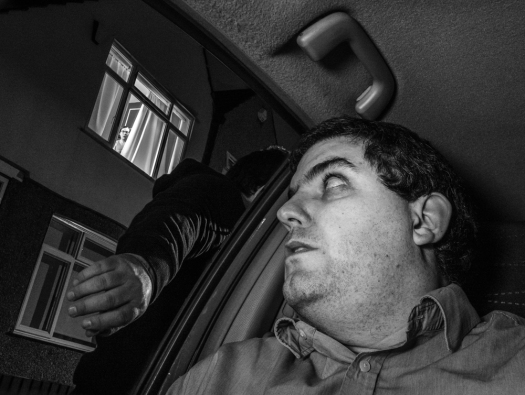



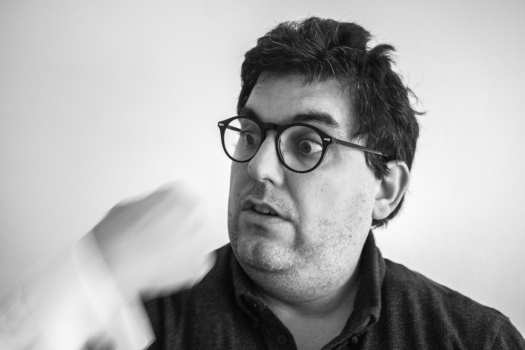






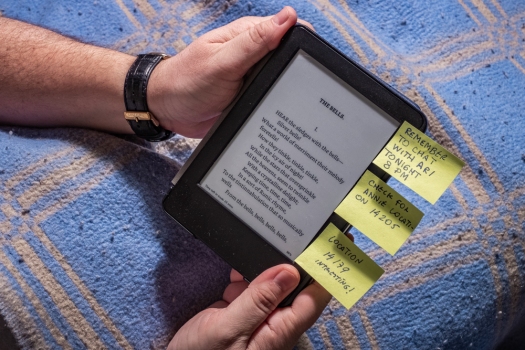














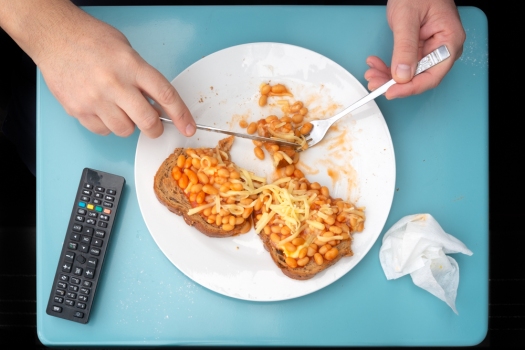


 My second attempt was using a spotlight from the other side of the room, opposite the window. In here, the light was more directional but also harsher, creating strong highlight blocks in the curtains and the frames of the windows (see figure 2 below).
My second attempt was using a spotlight from the other side of the room, opposite the window. In here, the light was more directional but also harsher, creating strong highlight blocks in the curtains and the frames of the windows (see figure 2 below). A final attempt was made by using a light box just on the side next to the subject. This to me created the best effect in terms of achieving the desired side illumination of the subject without brightening the inside of the room excessively (see figure 3 below).
A final attempt was made by using a light box just on the side next to the subject. This to me created the best effect in terms of achieving the desired side illumination of the subject without brightening the inside of the room excessively (see figure 3 below). I also did some tests inside the car. The first attempts were made with a mobile phone, equipped with a 31mm equivalent lens. This gave a slightly more compressed view than what I was looking for, and did not allow much by way of context, but I felt that it provided an interesting basis to work with.
I also did some tests inside the car. The first attempts were made with a mobile phone, equipped with a 31mm equivalent lens. This gave a slightly more compressed view than what I was looking for, and did not allow much by way of context, but I felt that it provided an interesting basis to work with. Following these proof of concept shots, I decided to concentrate on the picture from inside the car. The reason for this is that it allows me to show the face of the driver and to play with his expression in order to convey his anguish, as described at the end of the story. In the picture from the top room, the character would have to be shown in profile and this did not allow for any expressiveness, diminishing the impact of the image. I also was more pleased with how the elements balanced out in the car shot. The second test was performed with a 14-28mm equivalent zoom lens. I tried to place the camera in a similar place where I had my mobile, just behind the helm.
Following these proof of concept shots, I decided to concentrate on the picture from inside the car. The reason for this is that it allows me to show the face of the driver and to play with his expression in order to convey his anguish, as described at the end of the story. In the picture from the top room, the character would have to be shown in profile and this did not allow for any expressiveness, diminishing the impact of the image. I also was more pleased with how the elements balanced out in the car shot. The second test was performed with a 14-28mm equivalent zoom lens. I tried to place the camera in a similar place where I had my mobile, just behind the helm. Following the second test, I decided to tackle the illumination problems in the two sets separately. The upper room set was illuminated using a large soft box on the right hand side, which would provide the main source of illumination, and a small LED box on the left hand side to provide fill light on the other side, complemented by a bed-side lamp with a warm lightbulb. Initially I also kept the main room light on, but this resulted in too much illumination for the upper room, compared with the light available inside the car, which made balancing the final exposure more difficult. In the end, I decided to turn this off and just leave the bedside table light on, together with the soft-box and LED box. The main lighting set-up for the upper room is shown below.
Following the second test, I decided to tackle the illumination problems in the two sets separately. The upper room set was illuminated using a large soft box on the right hand side, which would provide the main source of illumination, and a small LED box on the left hand side to provide fill light on the other side, complemented by a bed-side lamp with a warm lightbulb. Initially I also kept the main room light on, but this resulted in too much illumination for the upper room, compared with the light available inside the car, which made balancing the final exposure more difficult. In the end, I decided to turn this off and just leave the bedside table light on, together with the soft-box and LED box. The main lighting set-up for the upper room is shown below. Inside the car, I had two main problems. The roof was too dark and the overall illumination of the subject was too poor. In the story, the character is playing with his phone while he waits for the recovery service. I decided it would be a good idea then to complement the ambient light by illumination from a phone, placed in front of the subject close to where the camera was set. The car has a cup holder next to the door and it would fit a mobile phone. It is conceivable that the driver would place his phone here while he takes a break from the Internet and watches the stranger that has captured his attention and has him worried for some time now (as per the storyline). This not only lifted the subject but also added some light to the roof of the car, which was primarily large black surface in the test pictures. In order to stabilize the camera in position, I crafted a narrow support plank with 5mm foam board, to which a flash bracket was fixed in order to be able to mount the camera and allow for some side adjustments for framing. The plank was resting on the main steering column on one side and on a tripod on the other. A pre-final test was taken to check for any final lighting problems and also to determine the final position of the characters:
Inside the car, I had two main problems. The roof was too dark and the overall illumination of the subject was too poor. In the story, the character is playing with his phone while he waits for the recovery service. I decided it would be a good idea then to complement the ambient light by illumination from a phone, placed in front of the subject close to where the camera was set. The car has a cup holder next to the door and it would fit a mobile phone. It is conceivable that the driver would place his phone here while he takes a break from the Internet and watches the stranger that has captured his attention and has him worried for some time now (as per the storyline). This not only lifted the subject but also added some light to the roof of the car, which was primarily large black surface in the test pictures. In order to stabilize the camera in position, I crafted a narrow support plank with 5mm foam board, to which a flash bracket was fixed in order to be able to mount the camera and allow for some side adjustments for framing. The plank was resting on the main steering column on one side and on a tripod on the other. A pre-final test was taken to check for any final lighting problems and also to determine the final position of the characters: For the final shot, I decided to try two alternatives to the mobile phone I used to illuminate the subject inside the car, as I still thought that the car and room illumination was too unbalanced. The first one was a small LED flash (two LEDs), but this source of illumination proved to be too strong and harsh on the subject. The second option was to use a tablet to illuminate the subject rather than a phone. In the end, the latter was the preferred option given that it provided a large, soft source of light and enabled a better balance between the two sets (as previously advised, I also reduced the light inside the second set in the upper room). Because this light essentially cancelled the slant shadow created by the external lamp-post, I experimented by adding a second led light on a stand just outside the car to complement the street light, but in the end decided not to use it for the final shot.
For the final shot, I decided to try two alternatives to the mobile phone I used to illuminate the subject inside the car, as I still thought that the car and room illumination was too unbalanced. The first one was a small LED flash (two LEDs), but this source of illumination proved to be too strong and harsh on the subject. The second option was to use a tablet to illuminate the subject rather than a phone. In the end, the latter was the preferred option given that it provided a large, soft source of light and enabled a better balance between the two sets (as previously advised, I also reduced the light inside the second set in the upper room). Because this light essentially cancelled the slant shadow created by the external lamp-post, I experimented by adding a second led light on a stand just outside the car to complement the street light, but in the end decided not to use it for the final shot.

 The final shot was taken with the characters dressed as intended. The man (myself) on the car was wearing a long, clear smart shirt, as if he was returning home from a long day at the office. I opted for clear tones here to aid with the illumination, as previous tests with darker casual clothing resulted in almost no highlights inside the car. The subject wore no glasses to avoid any distracting specular highlights. The character in the upper room (my partner) was told to look down towards the subject inside the car, who in turn is looking away, with a stern, concerned look. It is like if the characters were serially connected rather than making direct contact with each other, their anguish traveling from the upper room set, to the car, and then out of the frame.Technically, the final photograph, which is shown below, was taken as two separate exposures, one focused on the interior of the car and a second one focused on the window of the upper room. Both exposures where then combined in Photoshop. Distracting specular highlights and reflections on the house windows were cloned out or toned down in post processing. Other than this, most of the post processing adjustments where for colour balance, white / black points and shadow levels, with mild noise reduction applied. The picture was cropped to a 6×7 format to reduce negative space on the right hand side and to increase tension by having the main character looking out so close to the edge of the frame.
The final shot was taken with the characters dressed as intended. The man (myself) on the car was wearing a long, clear smart shirt, as if he was returning home from a long day at the office. I opted for clear tones here to aid with the illumination, as previous tests with darker casual clothing resulted in almost no highlights inside the car. The subject wore no glasses to avoid any distracting specular highlights. The character in the upper room (my partner) was told to look down towards the subject inside the car, who in turn is looking away, with a stern, concerned look. It is like if the characters were serially connected rather than making direct contact with each other, their anguish traveling from the upper room set, to the car, and then out of the frame.Technically, the final photograph, which is shown below, was taken as two separate exposures, one focused on the interior of the car and a second one focused on the window of the upper room. Both exposures where then combined in Photoshop. Distracting specular highlights and reflections on the house windows were cloned out or toned down in post processing. Other than this, most of the post processing adjustments where for colour balance, white / black points and shadow levels, with mild noise reduction applied. The picture was cropped to a 6×7 format to reduce negative space on the right hand side and to increase tension by having the main character looking out so close to the edge of the frame.